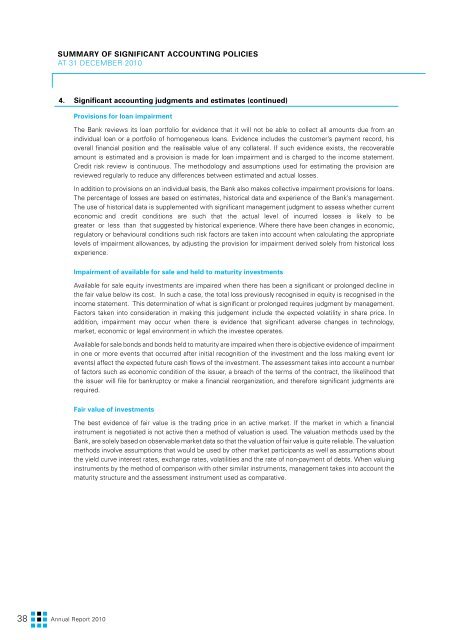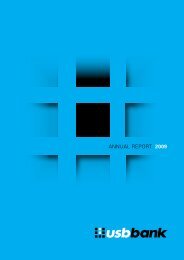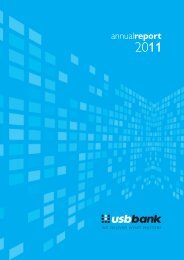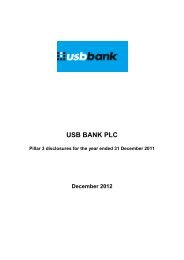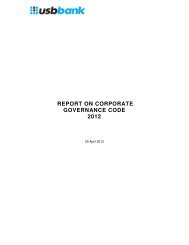Annual Report 2010 (PDF) - USB Bank
Annual Report 2010 (PDF) - USB Bank
Annual Report 2010 (PDF) - USB Bank
Create successful ePaper yourself
Turn your PDF publications into a flip-book with our unique Google optimized e-Paper software.
Summary of Significant Accounting Policies<br />
at 31 December <strong>2010</strong><br />
4. Significant accounting judgments and estimates (continued)<br />
Provisions for loan impairment<br />
The <strong>Bank</strong> reviews its loan portfolio for evidence that it will not be able to collect all amounts due from an<br />
individual loan or a portfolio of homogeneous loans. Evidence includes the customer’s payment record, his<br />
overall financial position and the realisable value of any collateral. If such evidence exists, the recoverable<br />
amount is estimated and a provision is made for loan impairment and is charged to the income statement.<br />
Credit risk review is continuous. The methodology and assumptions used for estimating the provision are<br />
reviewed regularly to reduce any differences between estimated and actual losses.<br />
In addition to provisions on an individual basis, the <strong>Bank</strong> also makes collective impairment provisions for loans.<br />
The percentage of losses are based on estimates, historical data and experience of the <strong>Bank</strong>’s management.<br />
The use of historical data is supplemented with significant management judgment to assess whether current<br />
economic and credit conditions are such that the actual level of incurred losses is likely to be<br />
greater or less than that suggested by historical experience. Where there have been changes in economic,<br />
regulatory or behavioural conditions such risk factors are taken into account when calculating the appropriate<br />
levels of impairment allowances, by adjusting the provision for impairment derived solely from historical loss<br />
experience.<br />
Impairment of available for sale and held to maturity investments<br />
Available for sale equity investments are impaired when there has been a significant or prolonged decline in<br />
the fair value below its cost. In such a case, the total loss previously recognised in equity is recognised in the<br />
income statement. This determination of what is significant or prolonged requires judgment by management.<br />
Factors taken into consideration in making this judgement include the expected volatility in share price. In<br />
addition, impairment may occur when there is evidence that significant adverse changes in technology,<br />
market, economic or legal environment in which the investee operates.<br />
Available for sale bonds and bonds held to maturity are impaired when there is objective evidence of impairment<br />
in one or more events that occurred after initial recognition of the investment and the loss making event (or<br />
events) affect the expected future cash flows of the investment. The assessment takes into account a number<br />
of factors such as economic condition of the issuer, a breach of the terms of the contract, the likelihood that<br />
the issuer will file for bankruptcy or make a financial reorganization, and therefore significant judgments are<br />
required.<br />
Fair value of investments<br />
The best evidence of fair value is the trading price in an active market. If the market in which a financial<br />
instrument is negotiated is not active then a method of valuation is used. The valuation methods used by the<br />
<strong>Bank</strong>, are solely based on observable market data so that the valuation of fair value is quite reliable. The valuation<br />
methods involve assumptions that would be used by other market participants as well as assumptions about<br />
the yield curve interest rates, exchange rates, volatilities and the rate of non-payment of debts. When valuing<br />
instruments by the method of comparison with other similar instruments, management takes into account the<br />
maturity structure and the assessment instrument used as comparative.<br />
38<br />
Αnnual <strong>Report</strong> <strong>2010</strong>


